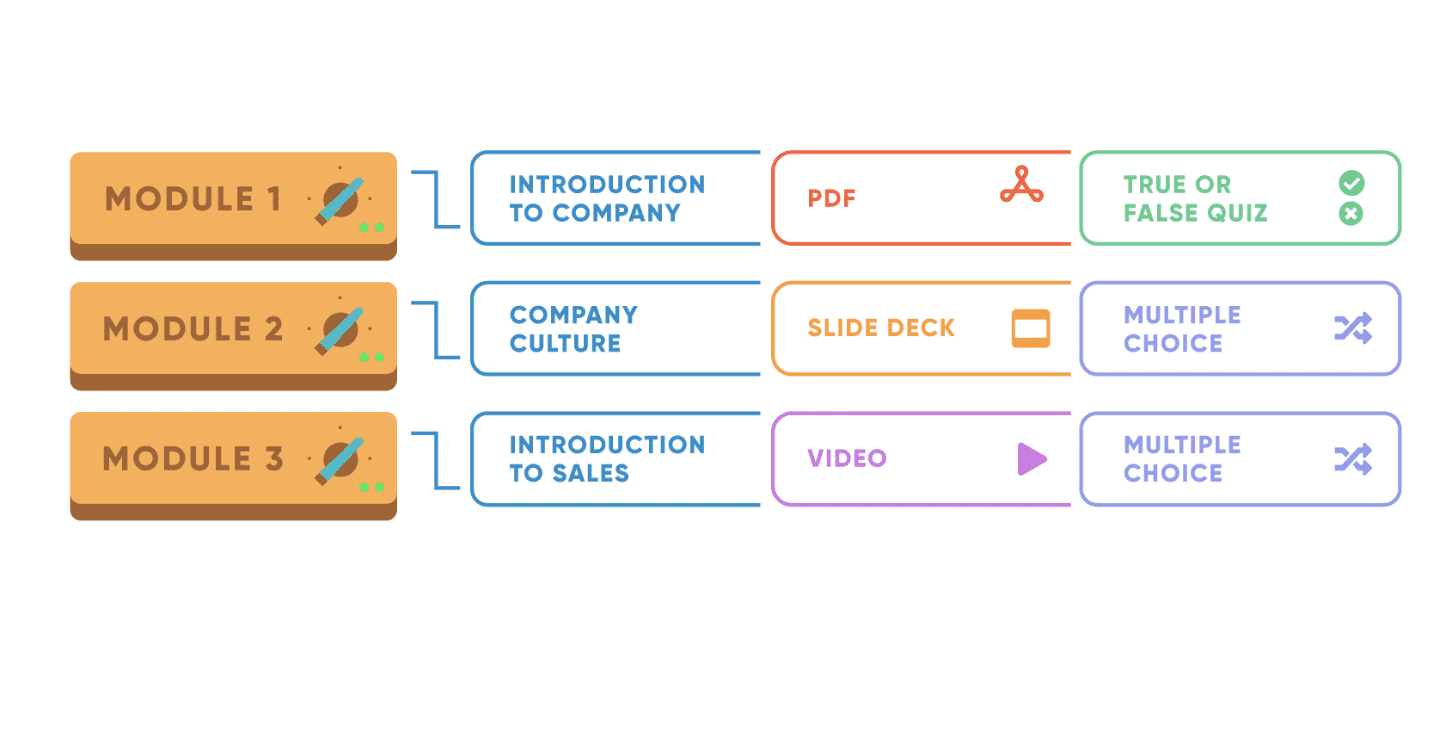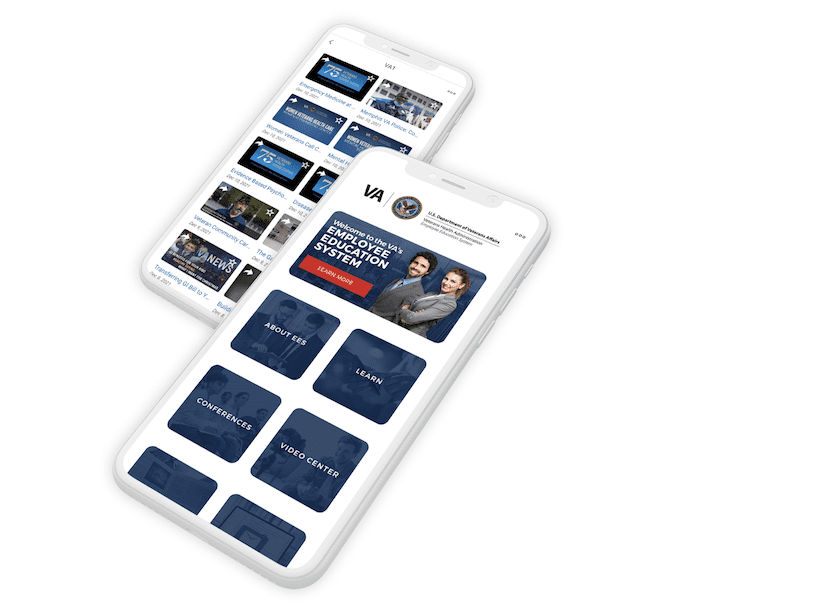How to Create Modules For Training Employees

Effective employee training builds the foundation for successful organizations. It ensures your staff learns the job-related skills required to perform their duties while further developing their careers and setting them up for success within your company.
In fact, 86% of HR leaders say that employee training is critical for retaining talent. Businesses with comprehensive employee training programs generate 218% more revenue per employee compared to those without formal training. Furthermore, 92% of employees say that workplace training has a positive impact on their engagement, and 90% say they’re less likely to leave a company that offers development opportunities.
Training modules are one of the most effective ways to train employees. Companies can build a training module for virtually any use case or learning initiative. Staff can complete modules at their own pace, while leaders can track and measure the results.
If you’re interested in creating modules for training employees, you’ve come to the right place. I’ll break down the different ways you can use online training modules and types of training modules before walking you through the step-by-step process of building one that delivers real results.
What is a Training Module?
A training module is a self-contained element of instructional information that focuses on a specific topic within a broader training program. Each module is designed to provide learners with skills, knowledge, and information related to a particular subject matter.
Create a Mobile App for FREE with BuildFire
Training modules are components of an online course or instructional guide. Typically, multiple modules must be finished to complete a course or earn a certification.
It’s common for training modules to be delivered through an online or mobile learning management system. Within each module, there’s a range of content that’s used for training—most often starting with informational content before formal assessments and evaluations.
For example, modules may start with a slideshow or video before testing what’s been learned through a quiz or test.

Ways to Use Module Training For Employees
Module training can be used for any type of educational setting. But within the realm of an employee training program, these are the most common ways to use a modular training course:
- New hire training, onboarding, and orientation
- Leadership training
- Sales coaching
- Product training
- Job-specific technical training
- Employee safety training
- Diversity training
- Mandatory corporate training (sexual harassment, soft skills, etc).
- Cybersecurity training protocols
You can create online training modules for virtually any type of learning objective within an organization.
Types of Training Modules
Employee training modules come in all different shapes and sizes. But you can mix and match your content delivery and training assessments based on the specific goal or learning objective of the module. Here are some common types of training modules used for employee training:
Online Course
This type of online training module is a comprehensive e-learning initiative that’s designed to inform learners about a specific topic. It’s commonly presented in a slideshow format with a mix of text, images, and videos. Once a slide has been consumed, the learner continues by clicking a “Next” button to proceed. Online courses work really well for providing sequential training with information that builds on what was previously taught.
Interactive Assessment
Interactive assessments are an engaging way to evaluate employees’ understanding of the training material. These assessments can include quizzes, drag-and-drop activities, or interactive simulations. The key is to make these assessments interactive and dynamic, allowing employees to apply what they’ve learned in a practical context. This type of module is particularly effective in measuring the retention of knowledge and skills, and it can be adapted for various topics ranging from product knowledge to compliance training.
Video Lectures and Presentations
Video lectures and presentations offer a visual and auditory learning experience that can be more engaging than text-based content. These modules can feature recorded lectures, interviews with experts, or animated explanations of complex concepts. They are particularly useful for delivering detailed information in an easily digestible format. Incorporating videos in training modules can enhance learners’ understanding and retention, especially for topics that benefit from visual demonstrations, like technical skills or product features.
Scenario-Based Learning
Scenario-based learning modules immerse employees in real-life situations relevant to their job roles. These scenarios require learners to make decisions based on the information provided—mimicking the challenges they may face in their actual work. This approach promotes critical thinking and problem-solving skills. Scenario-based learning is highly effective for training in areas like customer service, conflict resolution, and decision-making processes.
Microlearning
Microlearning involves creating short, focused training modules that cover a specific topic or skill in a concise manner. These modules are typically 5-10 minutes long and are ideal for busy employees who have limited time for training. Microlearning is effective for reinforcing key concepts, providing just-in-time training, and supporting ongoing learning. It’s suitable for topics that can be broken down into small, standalone units, such as software updates, policy changes, or quick tips.
Live Group Training
Live group training modules involve interactive sessions conducted in real time, either in-person or through video conferencing tools. These sessions can include workshops, webinars, or group discussions led by a trainer or subject matter expert. Live group training fosters collaboration and allows for immediate feedback and interaction among participants. It’s particularly useful for topics that benefit from group dynamics and discussion, such as leadership development, team building, and brainstorming sessions.

How to Create Online Training Modules For Employees (5 Steps)
Creating online training modules is easy when you follow specific guidelines. Use the five steps below to build each module.
Step 1 – Establish the Key Training Objectives
The first thing you need to do is determine the learning objectives for each module. By definition, a “module” is a set of independent units or parts of a more complete structure. So you don’t need to cram everything into one lesson.
For example, if you want to train employees about cybersecurity protocols, you can break this down into three separate modules—one for BYOD policies, another for password management, and a third for breach protocols.
Each module is completely independent of the other topics within the broader scope of cybersecurity. An employee doesn’t need to understand password policies to complete the module on breach protocols. But each of these is a key objective within the big picture of cybersecurity training.
Step 2 – Define Success For Each Training Module
Every module needs to have its own definition of “success” or “completion.” This can vary depending on the type of training.
For example, success for new hire onboarding may simply require an employee to watch a set of videos and consume content within a slideshow. The act of watching the video to completion and clicking the “next” button after each slide may be enough for this. Then you could collect a signature from the employee that acknowledges they’ve read all of the policies and understand what’s expected of them in the workplace.
Get Started With BuildFire Today!
Pick a template to start designing the app yourself, or let our professional design team build it for you.
- Mobile app development for iOS & Android
- No coding required
- 150+ pre-built features
- Unlimited customization
- 14 day free trial
But success for using a particular piece of software or obtaining credentials may look very different. For these types of training modules, the employee may need to take a quiz, test, or exam and get a passing grade (such as 90% or higher) to complete the module.
Step 3 – Determine the Right Content Format
The key to creating engaging training modules is picking the right way to distribute content for consumption. Text-only slides are boring and don’t always provide sufficient training for a particular subject matter.
Interactive lessons that require the employee to make clicks and answer questions along the way tend to be more engaging. Leverage video content, audio files, and images whenever possible.
You don’t need to stick with a standard training module template for every lesson. In fact, I advise against it. Changing the format based on the lesson is much more effective.
Step 4 – Create Training Modules
When creating training modules, it’s easier to treat each one as its own mini-course. That’s why it’s so important to break down the key objectives, success definition, and content format before you start building the training materials.
Here’s a sample of what you can include in just one module:

Don’t force content that doesn’t fit within the particular lesson.
Remember, each module is completely independent of the other. This means that some training modules could take two or three hours to complete, while others may only take 20-30 minutes.
Step 5 – Distribute and Track Results
Once you’ve completed your modules, it’s time to get them into the hands of your employees. It’s up to you to determine exactly when and how employees will use these. But try to tie them to specific job-related events or company-wide initiatives.
For example, when a new employee gets hired, they’ll automatically be sent the onboarding module through your company’s internal employee app. From there, they can complete modules related to various corporate policies and go through specific skills training.
If an employee switches roles or moves to a new department, they’ll automatically be sent the training materials for this new position. If you’re rolling out a new product or using new software, you can send training modules to everyone within the organization.
Some companies offer optional training for employees who want to advance specific skills and advance themselves within the company. Others roll out mandatory training sessions every year or quarter related to different HR initiatives and compliance.
It’s crucial to use a learning management system that accurately tracks who has completed what modules. Beyond completion rates, you need to assess how well the training translates into improved job performance. This type of data can help identify areas where employees are struggling and need additional support.
The Importance of Effective Employee Training For Your Company Culture
Employee training is far more important than simply ensuring your staff knows how to do their jobs. It ultimately helps enrich your company culture by creating employees who are skilled, engaged, and constantly advancing.
A recent survey found that 76% of employees were more likely to stay with an organization that offers continuous training.
Turnover rates are one of the most important KPIs when assessing company culture. If your office is like a revolving door, it instantly tells new employees that there probably isn’t much of a future for them within the company. But low turnover rates help build strong bonds between existing staff while conveying the message to new hires that they can be happy and grow within the company for the long haul.
39% of employees say that the potential for future growth within an organization is an important factor in job satisfaction. By offering training, you’re always giving your staff the opportunity to grow and succeed.
A whopping 86% of job seekers say they’ll avoid companies with a bad reputation. Meanwhile, 82% of business leaders say that a strong company culture gives them a competitive advantage in the workplace.
These results are measurable—with 46% of leaders saying that improving company culture leads to a boost in employee productivity and 38% saying it leads to increased employee engagement.
Final Thoughts — Using Mobile Apps For Employee Training Programs
Leveraging mobile apps for employee training programs presents an innovative and efficient way to enhance learning experiences. With solutions like BuildFire, you can create and deliver training modules directly to your staff’s smartphones—making learning accessible anytime and anywhere.
This approach perfectly aligns with the modern workforce’s preference for on-the-go and flexible learning options.
In fact, 58% of employees say that they want to learn at their own pace. Mobile apps give them this opportunity to complete modules in bite-sized sections whether they’re on the job, at home, or on the go. They can fit training into their busy schedules without distributing their workflow.
BuildFire lets you integrate various types of training modules into a user-friendly interface. From interactive assessments to video lectures, slides, and quizzes, everything can be distributed and completed from a smartphone or tablet.
This not only simplifies distribution and tracking but also engages employees in a more dynamic and personalized learning journey. The convenience of apps encourages higher participation rates with real-time analytics and feedback mechanisms.
By harnessing the power of mobile technology, you’re offering much more than an employee training solution—you’re fostering a culture of continuous learning and development within your organization.